Are you heading to Uganda with the hopes of seeing all of the epic locations? My Uganda Itinerary will help you do just that. It covers the major points of interest, and gets you the best of the best while leading you in a great loop around the country.
I spent 18 days self-driving Uganda, but here is what I consider to be the best experiences, distilled down into a more practical 10-12 days.
COVID Restrictions 2022
Before diving into my Uganda travel itinerary, we need to address COVID, and I have some good news.
At the time of writing, Uganda has begun to relax its COVID travel restrictions. International travelers who are fully vaccinated against COVID-19 may provide a valid certificate of vaccination to enter Uganda. That means vaccinated travelers can get in and out with no hassle.
Travelers who are not vaccinated, however, must still provide a negative PCR test completed no more than 72 hours before departure to both enter and exit Uganda.
So that means even though America no longer requires testing to reenter, Uganda won’t let you leave without it.
As always, be sure to follow up and check any restrictions at the time of your booking as they do tend to change often.
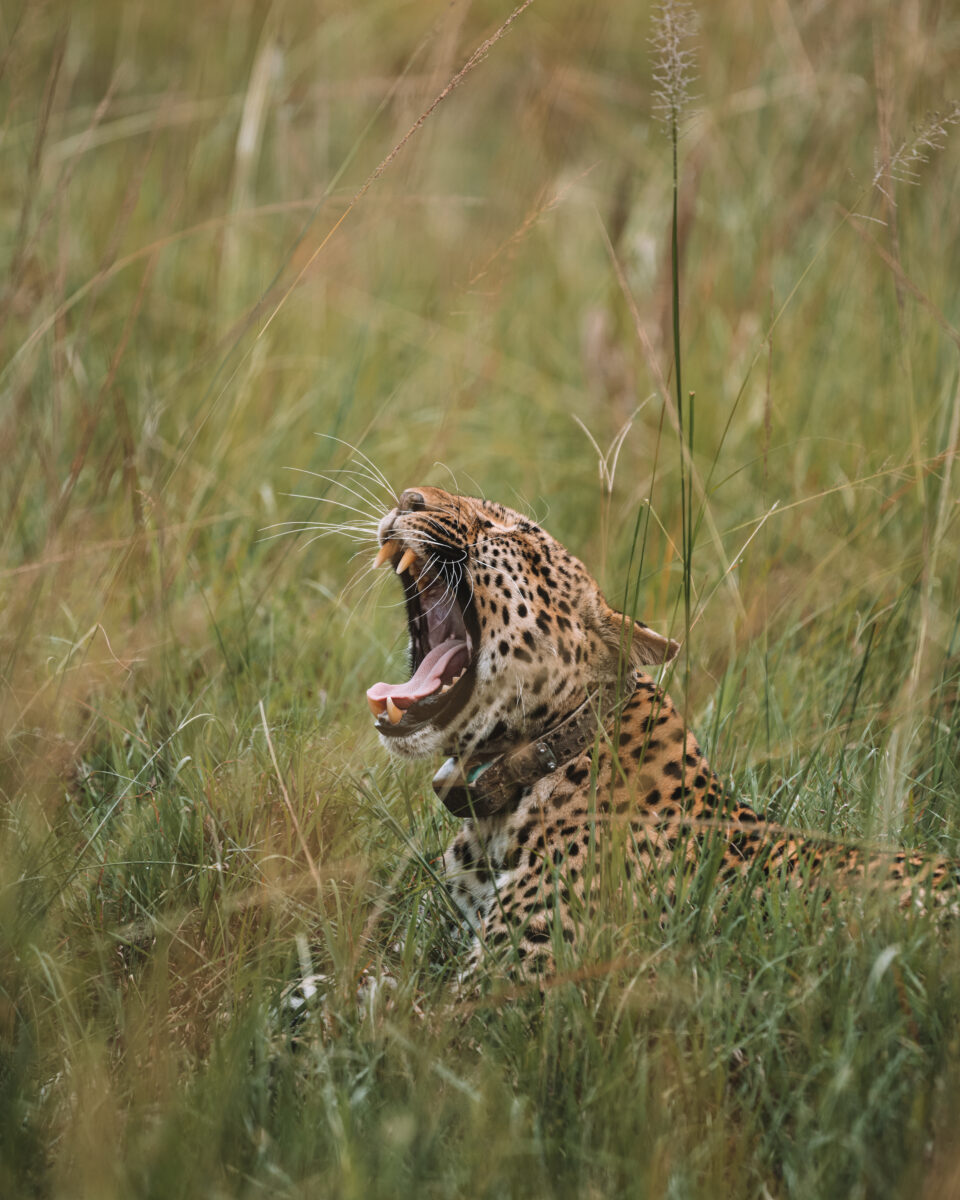
We never would have found this leopard in Queen Elizabeth National Park without an official guide.
Table of Contents
10-12 Day Uganda Travel Itinerary
One important thing about any Uganda travel itinerary is the length of the trip. Uganda is quite large, so you’re going to be doing a fair amount of driving no matter what. Substituting certain locations for others, or cutting some out will help with time management. It all comes down to which of these sites you want to see most.
I do offer a few alternatives at the end to help soften the driving blow, but other things I did, like Swamp Trekking in the Bigodi Wetlands Sanctuary (interesting) and visiting the city Fort Portal (underwhelming), I left out entirely for the sake of time.
Then, other locations, such as Murchison Falls National Park are just so far out of the way that you may choose to skip them altogether.
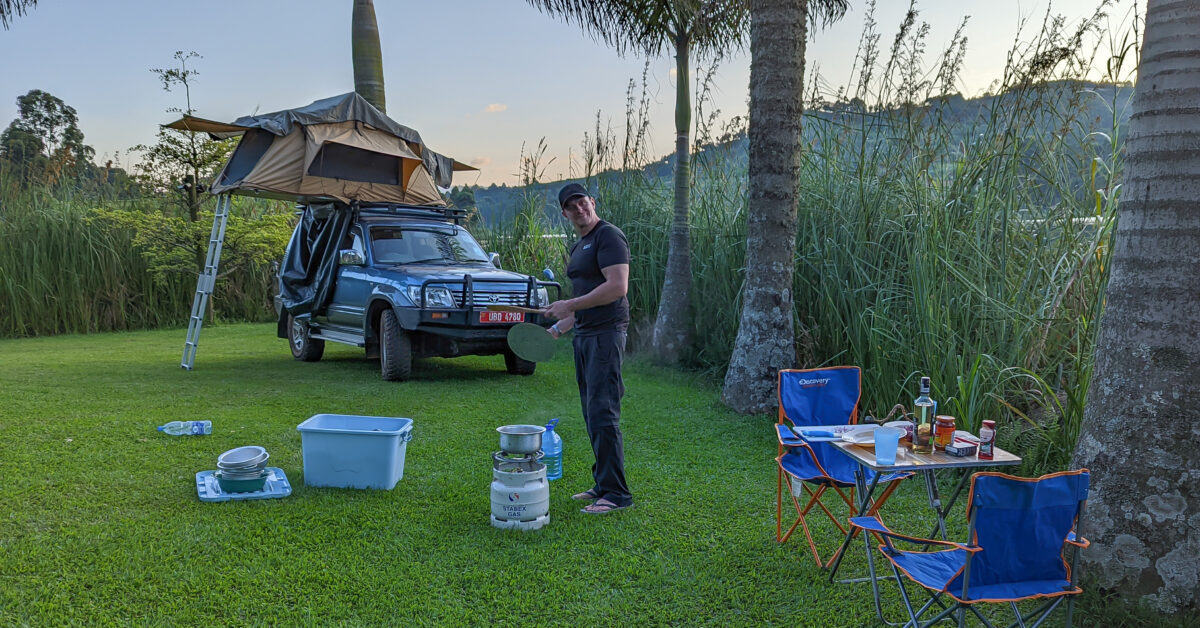
Home for the next few weeks! Let me tell you, this tent was sooooo extremely comfortable to sleep in!
The Direction You Take
If you’re in Uganda, chances are good that you’re there to see the mountain gorillas in their natural habitat. As such, the date you schedule your gorilla trekking for (this does need to be booked well in advance) will dictate the direction and speed of your route.
I scheduled gorilla trekking for early in the trip, so this meant my itinerary started in a southern direction. There is no right or wrong way as to which direction you should take, but I wanted to swing through Rwanda for a few days, so south it was.
Also be aware that there is a very long drive between Kampala and Bwindi, where you’ll find the gorillas. This drive is inevitable no matter which direction you go. So, do you want the long drive at the start or the end of your trip?
There are options to break it up, to a degree, and I have them listed at the bottom, but you’re still looking at a lot of driving regardless.
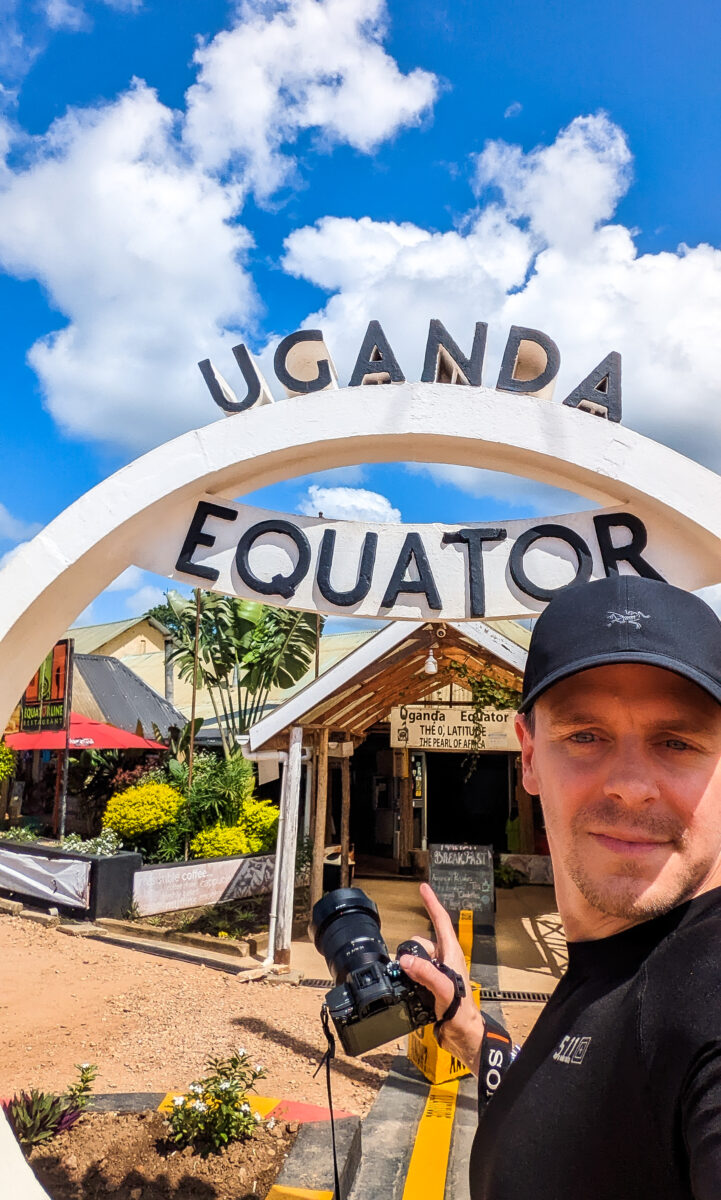
No matter which direction you go, you’ll be crossing the equator twice! There was a bit more fanfare here in Kayabwe when compared to crossing it on the other side of the country where it was only a small sign along the highway.
My Uganda Travel Itinerary
Bwindi Impenetrable Forest: 2-3 days
The Bwindi Impenetrable Forest is a large primeval forest located in southwestern Uganda in the Kanungu District. This is one of the most biologically diverse areas on Earth and is home to half of the world’s endangered mountain gorillas.
If you’re in Uganda to see gorillas, this is the place to be.
In addition, you’ll also find colobus monkeys, chimpanzees, and many birds such as hornbills and turacos.
It is known as the Impenetrable Forest as well as the “Place of Darkness” due to the thickness of the undergrowth, which is so thick that it severely hinders direct access on foot.
Be sure to check out my detailed post about how to see the amazing Mountain Gorillas of Uganda
The drive in and out is long and entirely on a dirt road that is full of potholes and ruts, so be sure you have a vehicle capable of making it. A car won’t make it. You need a 4×4.
I personally recommend staying at the Ruhija Gorilla Friends Resort & Campsite. It’s located in a small and very poor village, but the campsite was good and secure. By arriving the day before and spending the night, you’ll be able to avoid driving before dawn, which isn’t recommended.
If you do stay here, try to visit the orphanage and make a donation. It doesn’t look like they get much financial support. There are 250 young kids there who are all orphans from the small surrounding villages. While I was there, the kids were hand-sewing homemade school uniforms.
Had I known about its existence prior to my arrival, I would have bought a stack of clothing and winter hats from one of the markets. (It’s all very cheap, if you were looking for an idea.) Bwindi gets cold at night given the elevation.
Speaking of which… have you ever wondered where clothing from those donation bins ends up? I’m not positive, but I’m fairly certain that it makes its way to those markets.
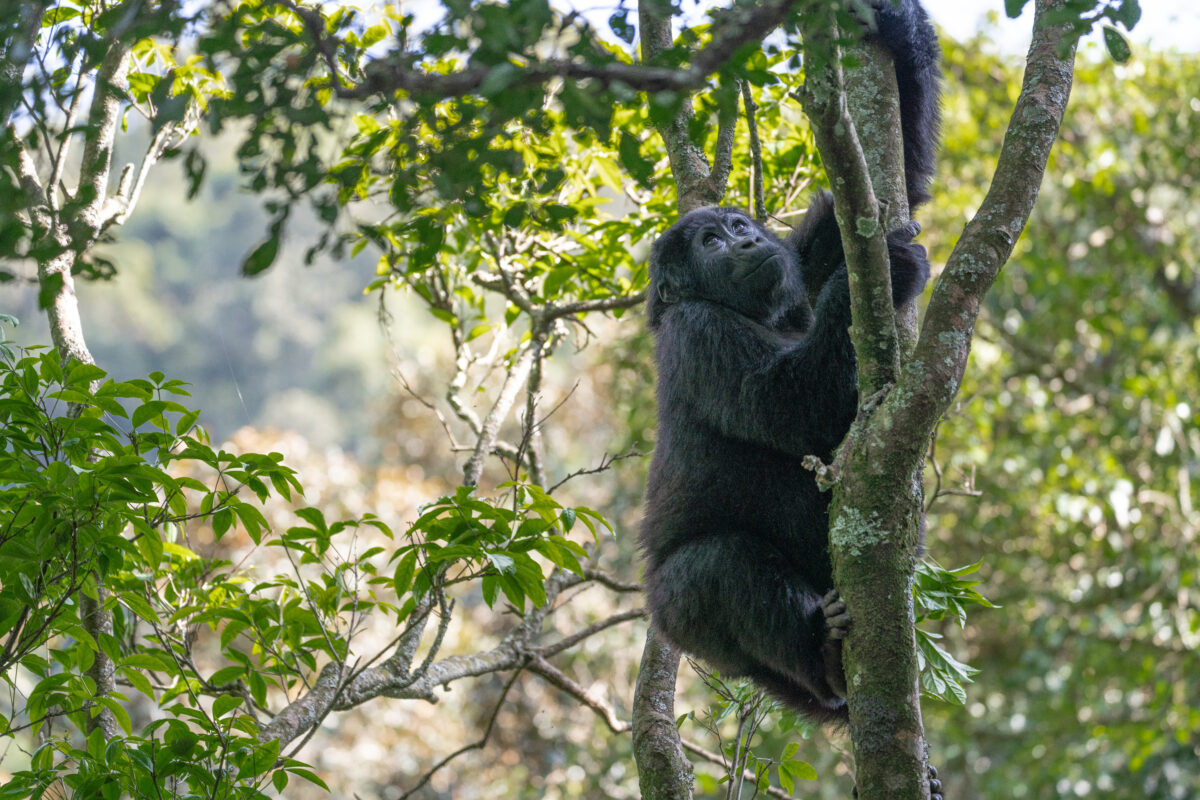
Gorilla trekking in Uganda at the Bwindi Impenetrable Forest!
Queen Elizabeth National Park: 2-3 days
The second stop on my Uganda itinerary is Queen Elizabeth National Park. This is a very good park, probably my favorite from the entire trip. It’s the most popular savanna park in Uganda as well as the best place to spot lions.
The lions here are famous for being tree climbers. In fact, while I was there, a crew from the BBC was recording a documentary about them. They were apparently complaining that they couldn’t get the shots they needed as they wanted the lions without tracking collars.
Joke’s on them because we had the collar-free cats walking right up to us! Take that, with your “special access”!
While here, we spotted four of the Big 5 animals with rhinos being the lone exception. (Wild rhinos can only be found at Ziwa; see below.)
You can self-drive here, but with any safari, I recommend hiring a guide through the park. Local guides know where to look; they’ll often give you better access, and they will communicate with other guides about where to find specific animals.
Our guide spent a lot of time on the phone with her friend trying to pin down the location of a leopard. We eventually found it, but a regular tour guide never would have, as it involved a lot of communication and some crafty maneuvering.
The real guides are slow to share information with outside “guides”, aka, whoever is driving your tour van around the country. Then, if you’re self-driving with no guide of any sort, they’ll flat-out ignore you.

The famous tree climbing Lions of Queen Elizabeth National Park.
Murchison Falls National Park: 2-3 days
Here you’ll have to choose between seeing Kibale National Park, and Murchison Falls National Park.
I chose Murchison, which is famous for being home of… you guessed it! Murchison Falls! It may not look it at first, but it’s the most powerful waterfall in the entire world, pumping out an absolute torrent of water.
Murchison Falls is one of several locations where you can participate in chimpanzee tracking. This takes place in Budongo Forest, which is located near the entrance to the park.
Chimpanzee tracking here has successful tracking rates of 90%. Other popular tourism activities include chimpanzee habituation, which is similar to tracking, but you’ll spend several hours with them, getting them accustomed to seeing humans.
While here, I also did one game drive, but having arrived late, we ended up with the only remaining guide. The best guides are usually the first to head out. While mine did know the layout of the park, it felt more like I was just driving her around.
Technically, you could see both parks. I personally only went to Murchison, but if you opt for Kibale, you will save yourself a lot of driving. Kibale does offer chimpanzee tracking as well, with some saying it’s the best in the country. I don’t know how much better it could possibly be as the chimps in Budongo Forest were all over the place, but you never know.
The primary reason I opted for Murchison Falls over Kibale was to see the waterfall.
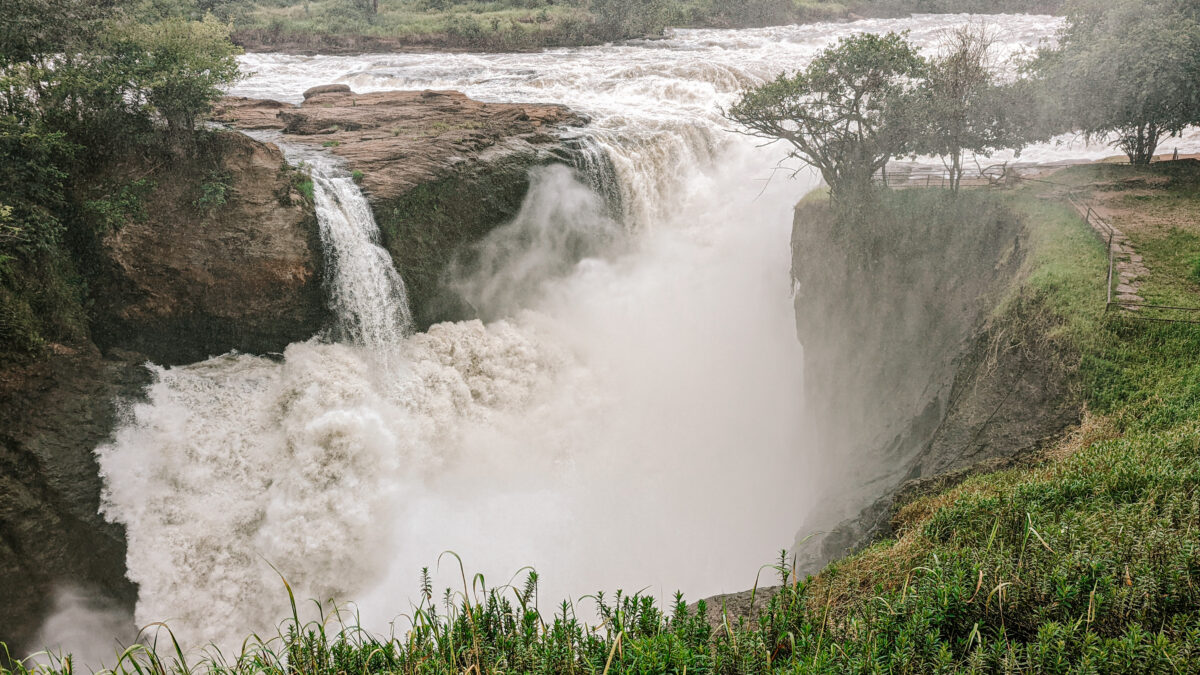
Murchison Falls – The most powerful waterfall in the entire world. The water shoots through with so much force that the ground shakes!
Ziwa Rhino Sanctuary: 1 day
The Ziwa Rhino Sanctuary in Nakitoma, Uganda offers you a truly unique experience. I’ve written a full post about the Ziwa Rhino Sanctuary, which you can find here, but the short of it is that this is the only place in Uganda where you’ll be able to see wild rhinos.
It’s also unique in that you track them on foot rather than in a vehicle. This allows you to get much closer than you would otherwise be able to. (Other parks require you to remain inside your vehicle for safety reasons.)
They also offer other things like birding and night tracking for those interested.
I spent about four hours here before moving on. While this isn’t a place you need to spend a full day at, they do have lodging and campsites available, so this is a good place to stop off on your way to Jinja.
Had I known at the time, I would have preferred to spend the night here. Instead, due to my driving partner’s fear of driving at night, we ended up getting stuck at a really bad hotel in the middle of nowhere.
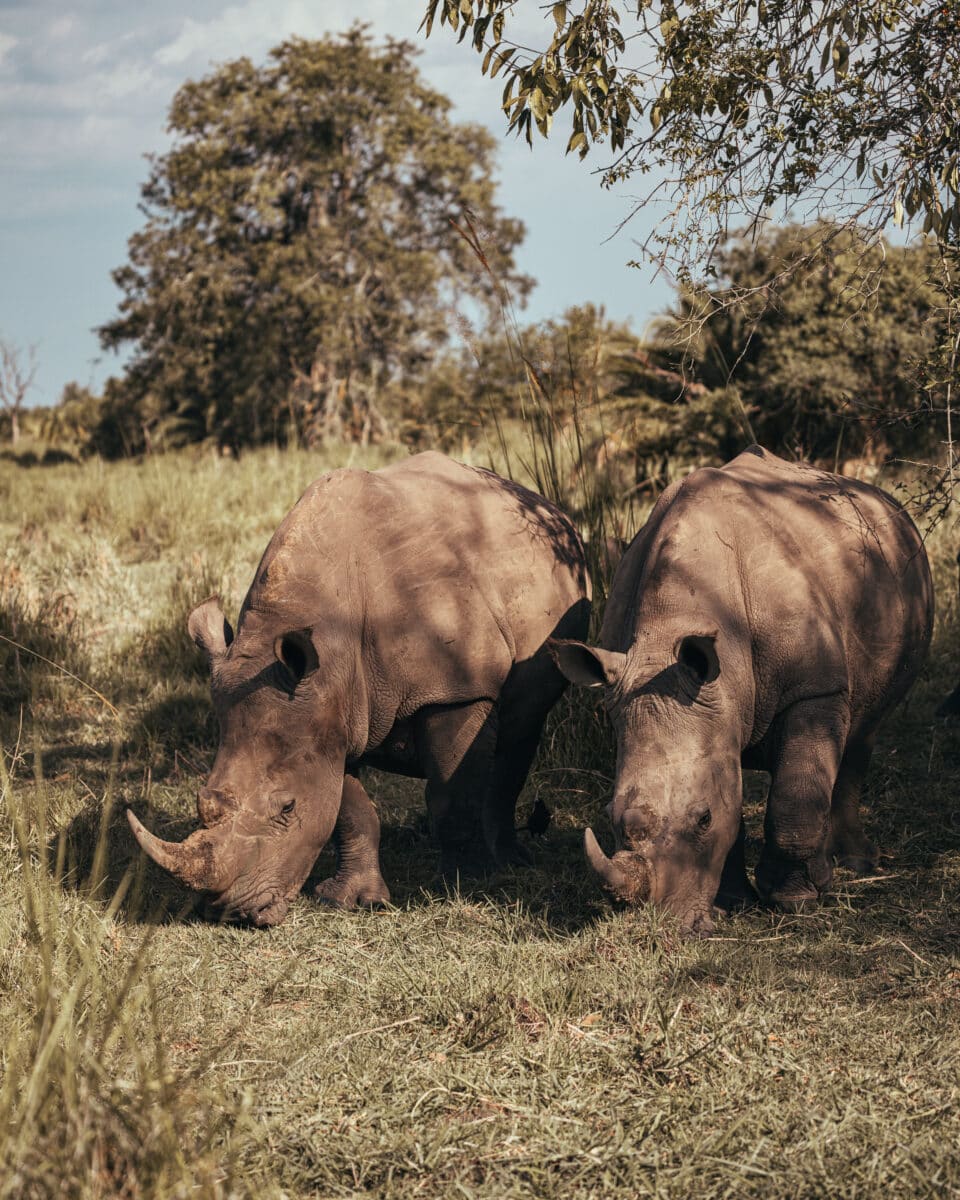
A couple of teenage rhinos loitering around at the Ziwa Rhino Sanctuary.
Jinja: 1-2 days
Jinja is where you will find the Source of the Nile River. It’s a massive spring right on the edge of Lake Victoria that you can literally see making the water swirl, even from a distance.
Beyond this, you should know that Jinja is a city and not part of a national park. I didn’t realize this prior to arrival and got a derisive laugh for not checking my map. Well, when you do 90% of the driving, when exactly do you have the chance? Oof.
It’s okay, though, because right next to Jinja you’ll find Mabira Central Forest Reserve. (This is what I thought Jinja was with all of the talk about ziplines and rafting.) While not on the same level as the other larger parks, this park is still worth a look for a decent nature walk and zipline.
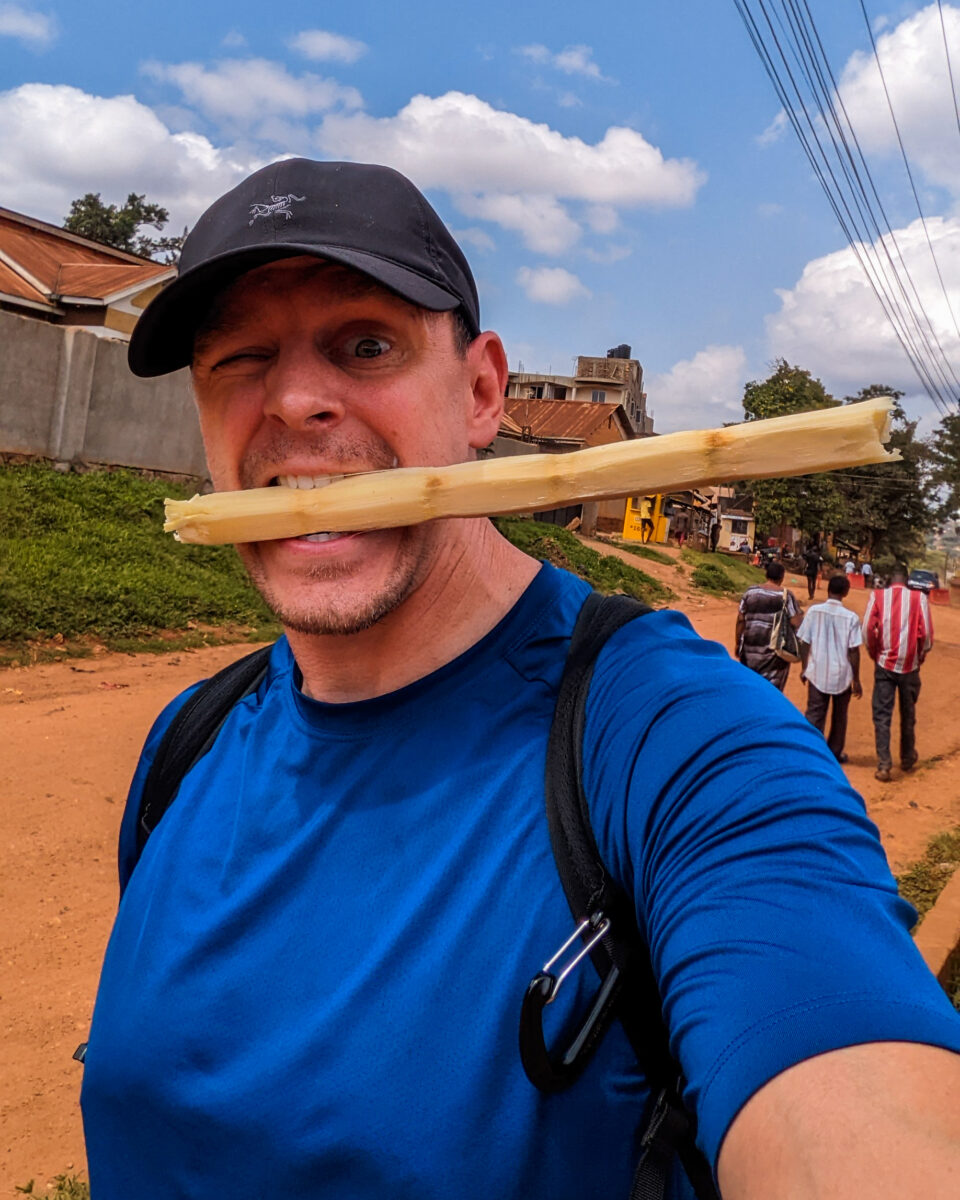
Sugar cane is a popular treat in Uganda so I wanted to try it. It was like chewing a sweet piece of wood. I’ll stick to snickers and Pez.
The White Nile River
The main draw to Jinja, though (after the Source of the Nile River) is the whitewater rafting scene. Rafting on the White Nile River, not to be confused with the Nile, is absolutely amazing. I thought it was better than rafting on the Pacaure River in Costa Rica.
It was an onslaught of Class IV and V rapids with two Class VI that are so large that porters need to walk the raft around the edge. The final rapid was the first to ever flip my raft and let me tell you, being slingshot through the air just to be sucked under the raft was thrilling! No, I am not insane. It’s Type-2 fun guys!
There were several rafts there, and we were the only ones to flip, so don’t worry, it’s not a given.
Multiple operators are available to use for rafting, but the one I used was Adrift. They also offer camping and lodges if you’re looking for a place to stay. If you plan on only spending one day but still wish to go rafting, you’ll need to be there very early as they depart for the river at around 8 a.m.
I stayed at Living Waters Resort in their camping area, which head over heels had the best view of all the campsites I stayed at in Uganda. It’s also where you’ll find the Speke Memorial and the spot where he discovered the Source of the Nile River.
The rafting company was willing to pick me up there and then drop me off after.
Kampala: 2-3 days
Kampala is the capital city of Uganda. This is where Entebbe Airport is located so you’ll most likely be either starting or finishing your Uganda travel itinerary here. I chose to end it here rather than explore Kampala right off the bat.
The reason I chose to end it here is threefold. First, I prefer to not end trips with a super long drive. Second, this saved a day because I didn’t get stuck without anything to do on the final day while waiting for my flight. Third, I chose to go to the gorillas early so I needed to get moving.
It’s certainly great to see, but there’s nothing in particular about Kampala that will blow you out of the water. I’d say my favorite part was exploring the many markets, even if I didn’t buy anything.
I highly recommend you take the free walking tour that I did. I felt that he covered quite a bit of ground and was well worth a good tip.
Just don’t take pictures in the slums. It’s completely classless. When told not to, someone in the group actually had the audacity to ask “why not?” Probably the most ignorant thing I ever heard in all my years of traveling.
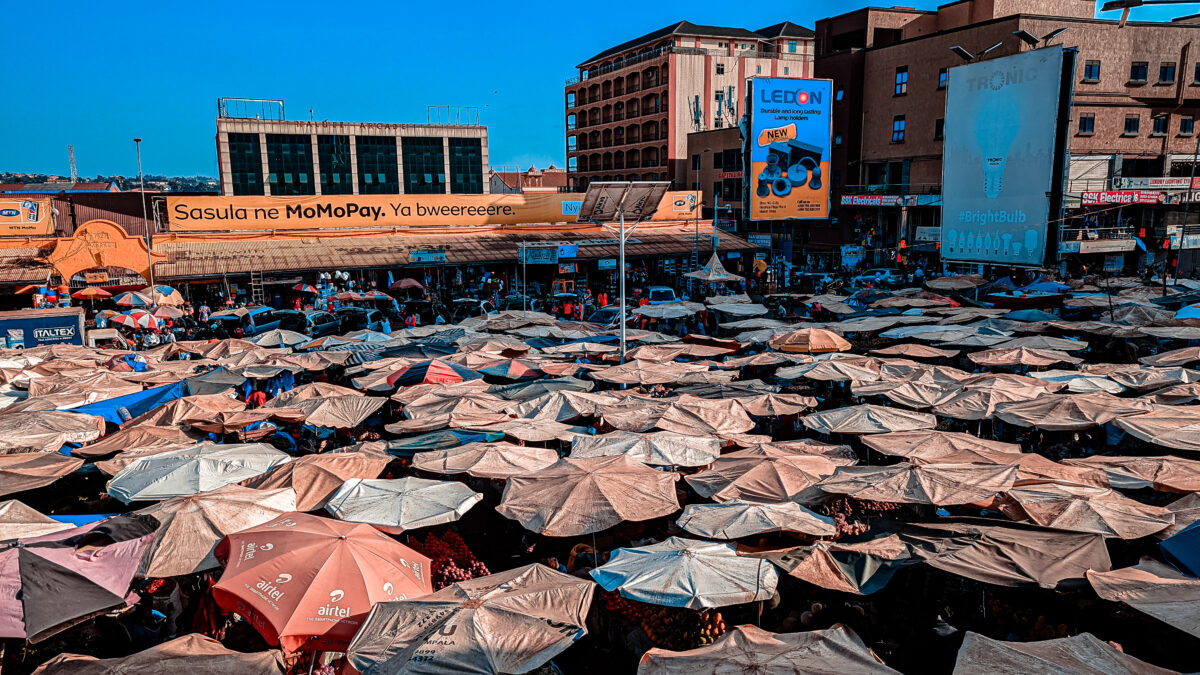
The markets of Kampala. here was someone standing up here who wanted to charge us for taking pictures until our guide argued with him.
Alternatives to break up the drive between Kampala and Bwindi Impenetrable Forest.
So here’s the rub. As mentioned, regardless of which Uganda travel itinerary you follow, Kampala to Bwindi Impenetrable Forest are pretty much set in stone as destinations, and the drive between them is very long, clocking in at around nine hours.
Luckily, there are two places that can help soften the blow.
These stops are Lake Bunyonyi and Lake Mburo National Park.
I opted for Lake Bunyonyi, but in retrospect, I wish I had skipped the lake and gone to Mburo instead.
Of course, you could always fly from one to the other, but that would then cause issues for securing a vehicle to further explore the country. Those who fly are generally the ones who are in Uganda to only see the gorillas.
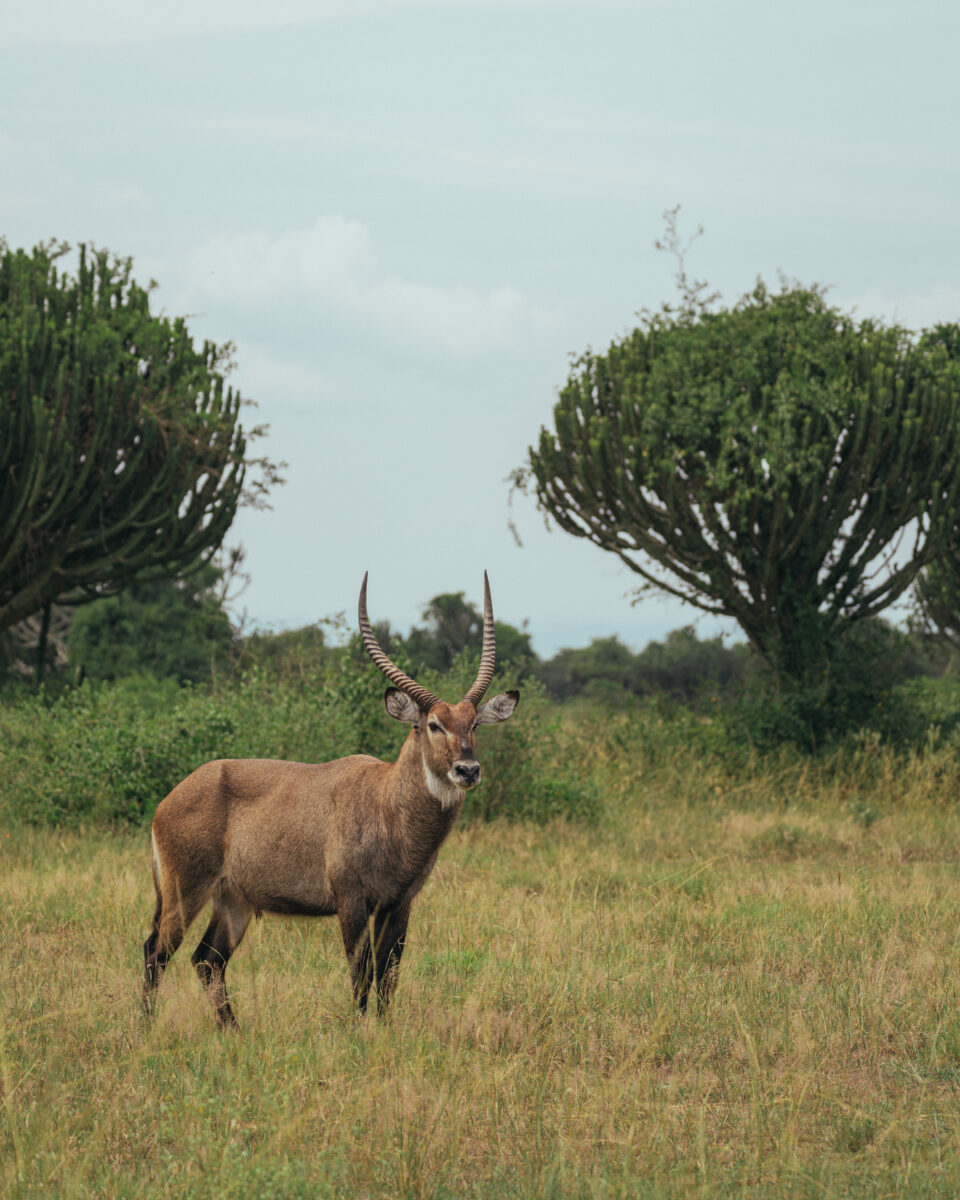
🤘
Lake Bunyonyi: 1-2 days
Lake Bunyonyi is a beautiful crater lake that is known for being one of the few lakes in Uganda that is free of hippos, crocodiles, and bilharzia (a common parasite found in southern Africa), making its waters safe for swimming. As it’s a crater, the water gets deep very fast so be sure that you’re a competent swimmer before you get in.
Birding, boat tours, and traditional canoe rentals are popular activities here. I rented a canoe and took it out to one of the islands for a few hours. It was nice and relaxing, but also arm-pumping since it was a windy day.
This lake is more of a place to sit back and chill in a relaxing environment so don’t expect anything more exciting.
Lake Bunyonyi is still a pretty long drive at seven to eight hours from Kampala, depending on which part of the lake you visit. Then you have around another three until you reach Bwindi Impenetrable Forest for the gorillas.
I’d say this is best for a decompression and relaxation stop at the end of your Uganda itinerary, rather than at the beginning when you’re raring to go.
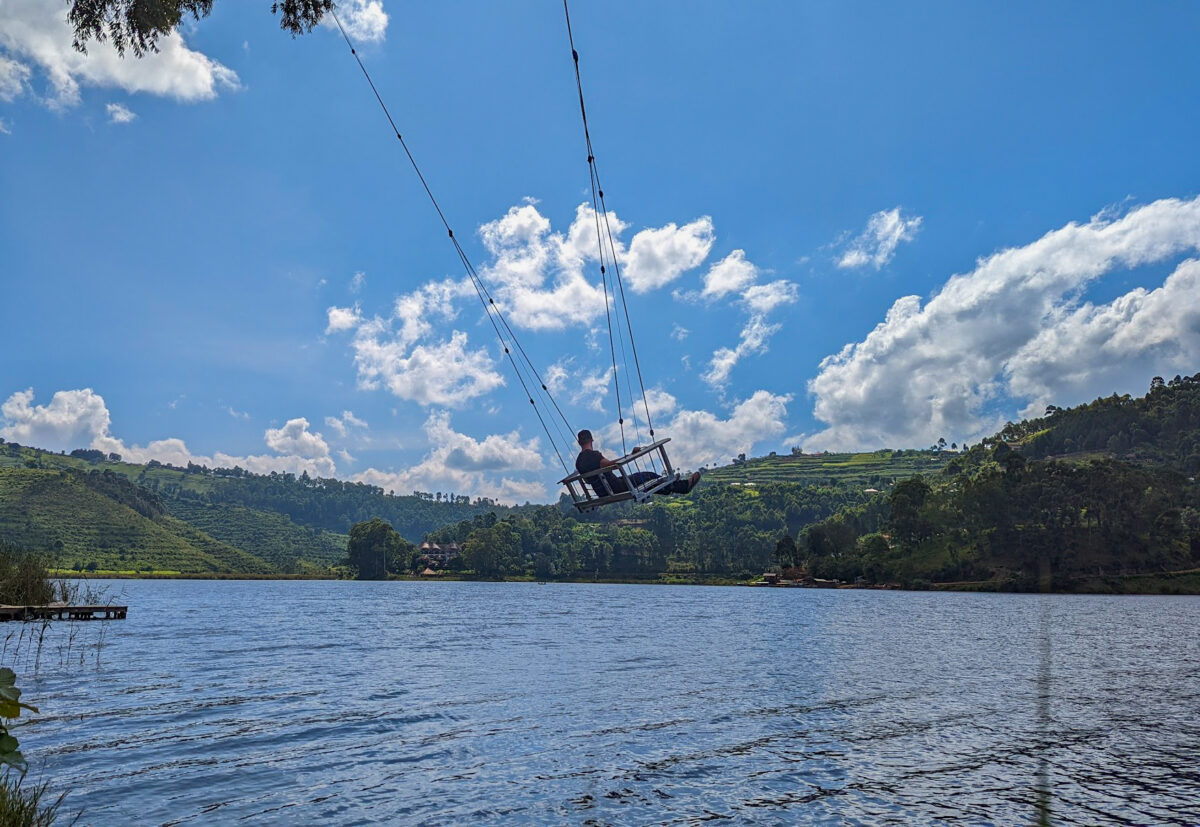
Swinging out over Lake Bunyonyi.
Lake Mburo National Park: 1-2 days
Lake Mburo National Park is the smallest of the savanna parks in Uganda, but it does offer you the chance to take a proper safari and see some animals that you won’t find in the other parks I list, such as zebras.
As I mentioned above, I didn’t stop at Lake Mburo, but in retrospect, I wish that I did as I found Lake Bunyonyi to be a bit boring. I also love safaris so I gladly would have paid to take another.
Stopping here instead of Bunyonyi also breaks up the driving better. You’ll still have either a 5.5-hour drive to Bunyonyi or 6.5-hour drive to Bwindi Impenetrable Forest, but either of those is better than driving eight or nine hours in a single day.
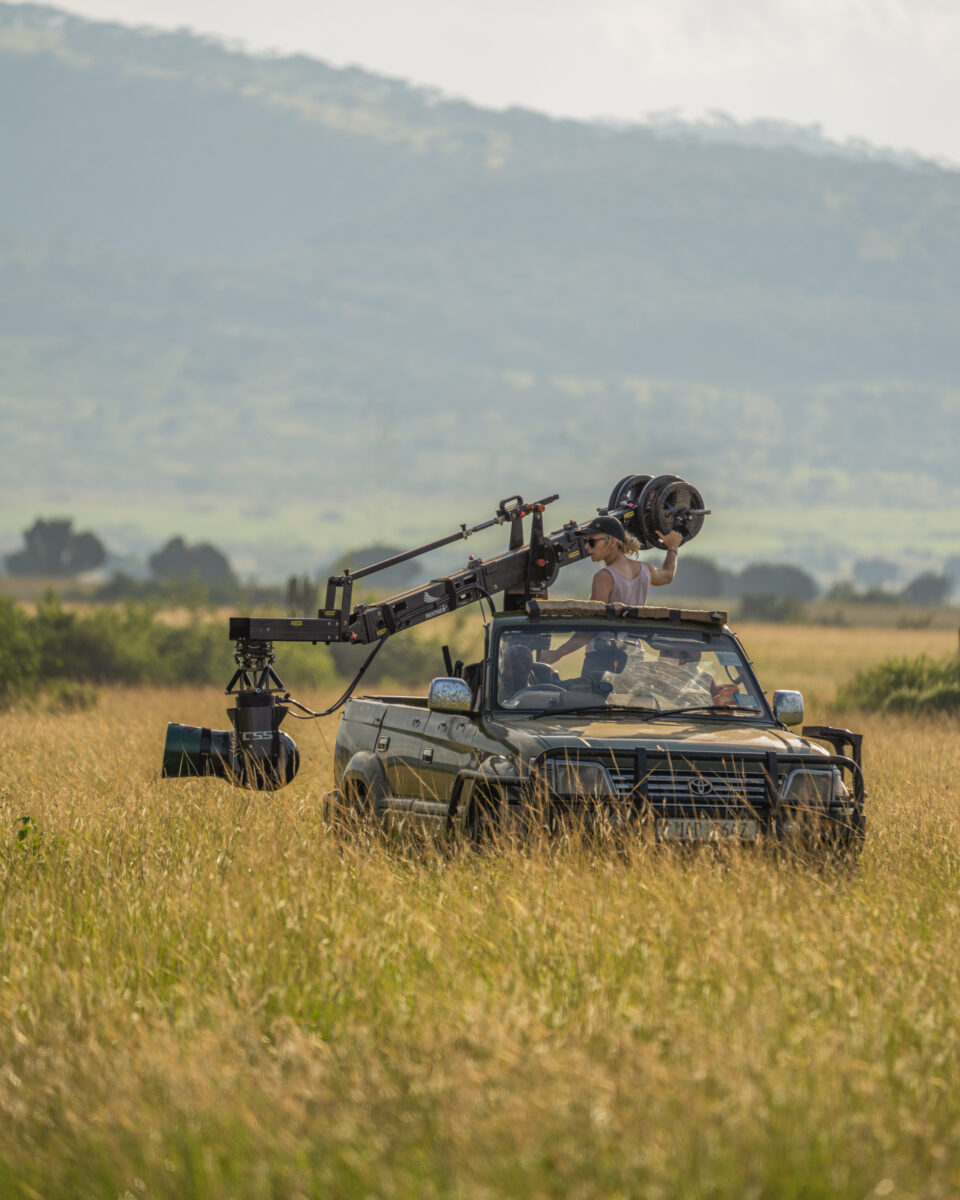
The BBC camera crew just driving wherever they want in Queen Elizabeth National Park.
Kibale National Park – An Alternative to Murchison Falls
Kibale National Park makes a great alternative to Murchison Falls if you are looking to save time. I really wanted to see the waterfall as well as the White Nile River, so the choice was made for Murchison.
Was it worth the several extra hours of driving? Ahh, I’m inclined to say yes, but I was also in Uganda for a lot longer than ten or twelve days and wasn’t concerned with saving time. Were I pressed for time, I may have made the swap.
My travel partner actually proposed this swap at one point but I shot it down. I was reading Into Africa at the time and Roderick Murchison features prominently. Plus, I like chasing waterfalls.
Beyond the waterfall and White Nile, though, both parks offer amazing chimpanzee tracking and game drives. Ideally, I wish I had done both.
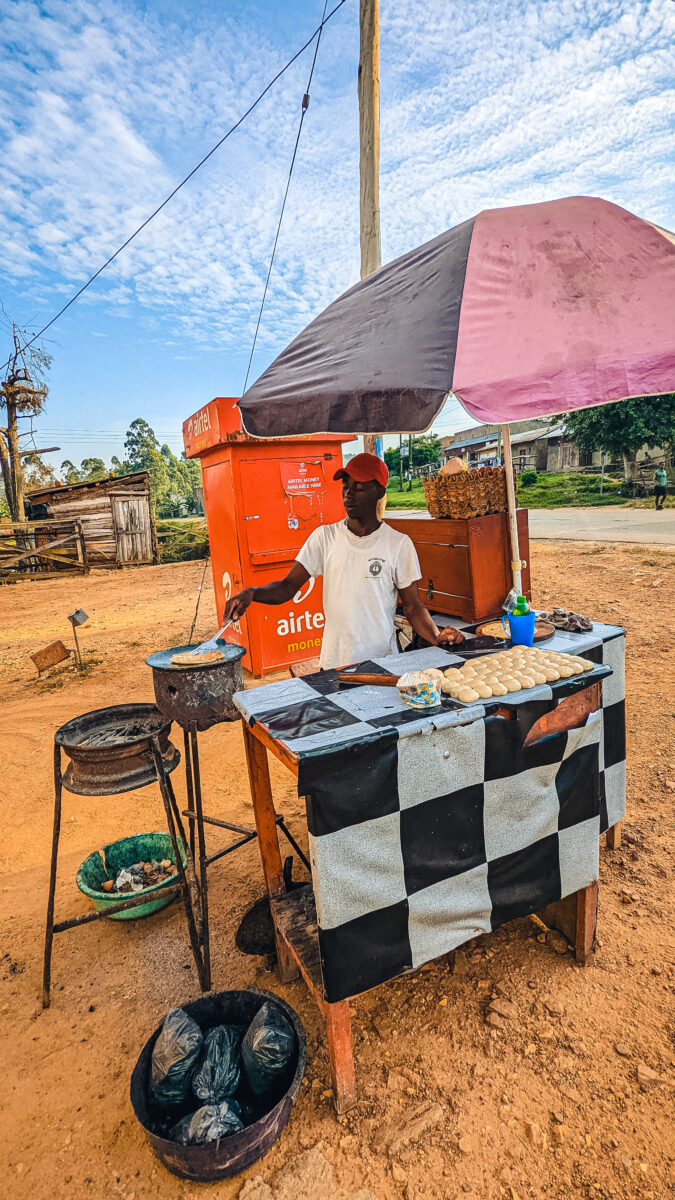
Not to be confused with the watches, a rolex is unofficially the signature food of Uganda. You can find them everywhere. They are basically an omelet wrapped in a chapati (flatbread).
Best time to visit Uganda
The first thing that needs to be considered when planning your Uganda itinerary is when to go.
Your priority here, as with most East African countries, should be to travel during the dry season. For Uganda, this occurs during the months of June through September and December into January.
The reason you want to travel during the dry season is that it’s generally considered to be the best time to visit most African countries if you are interested in seeing the animals.
Less rain means the parks are drier, which translates into easier viewing. This is due to several reasons such as sparse vegetation, concentrated water sources, and ease of traveling on dry trails and roads. Even the insects, particularly mosquitoes are easier to deal with during the dry season.
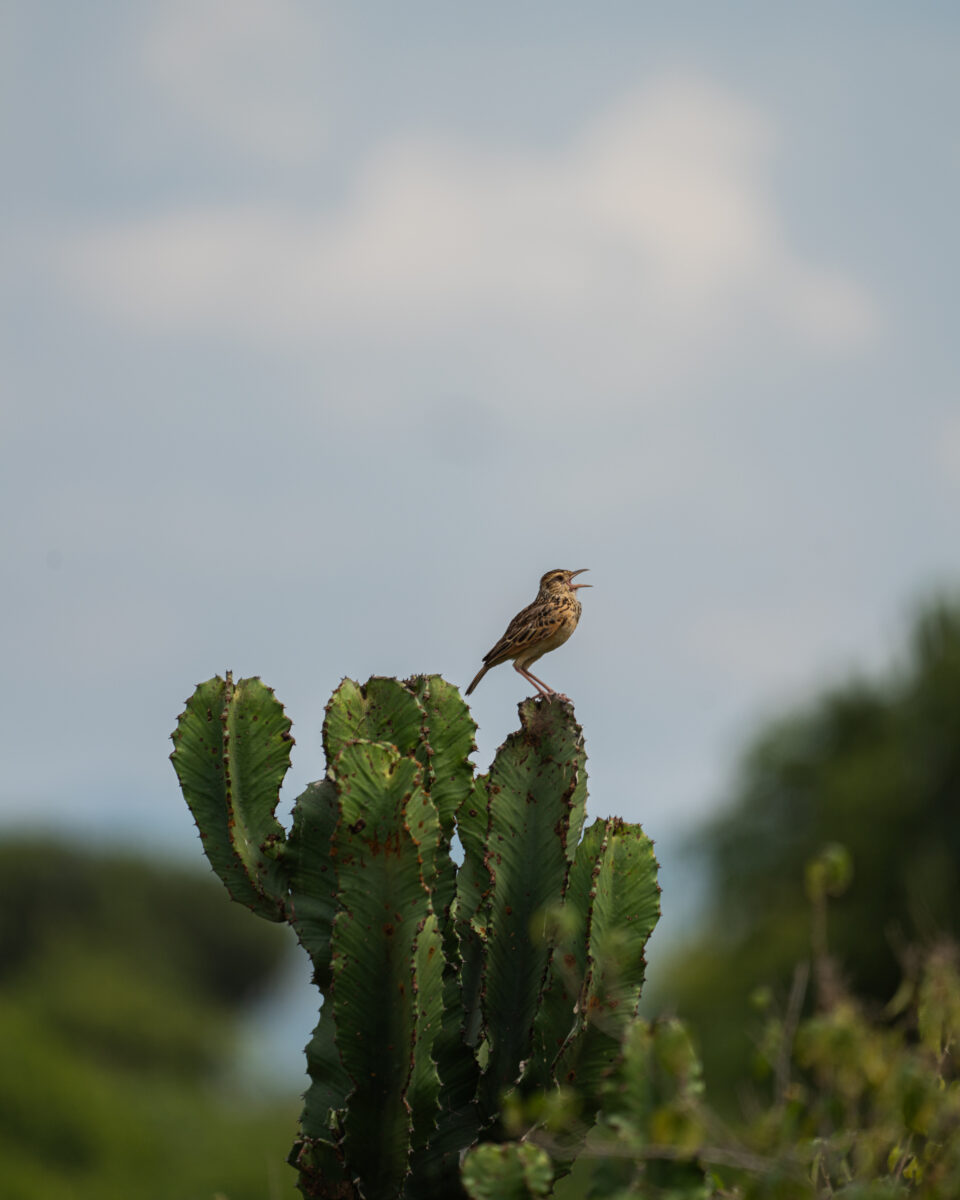
Tweet tweet.
How to get around Uganda
One thing about Uganda is that there are buses and taxis that will take you literally everywhere… provided you wait long enough. In general, bus travel appeared slow and very cramped, so I would recommend self-driving overland. I must have passed a thousand “taxi-buses.” (Think large vans packed with too many people.)
In that regard, everyone passes and overtakes slow-moving vehicles whenever they can. It’s an accepted practice, but, if the police see you and are looking for a bribe, they will pull you over.
The company I used was Self Drive Uganda. I rented a Toyota Prado Landcruiser with a rooftop tent for camping, and camping equipment. The camping equipment came up huge since this trip started off on a bad foot with the airline losing my main bag. It did eventually arrive, but I wasn’t able to retrieve it until the very day I left. Awesome.
Something substantial with four-wheel drive and good meaty tires is important when choosing your vehicle because many of the roads you’ll be on, especially in the national parks, will be unpaved and potentially steep. There were a few occasions where I needed to pop it into low gear to make it up a hill. Even then it was still just barely.
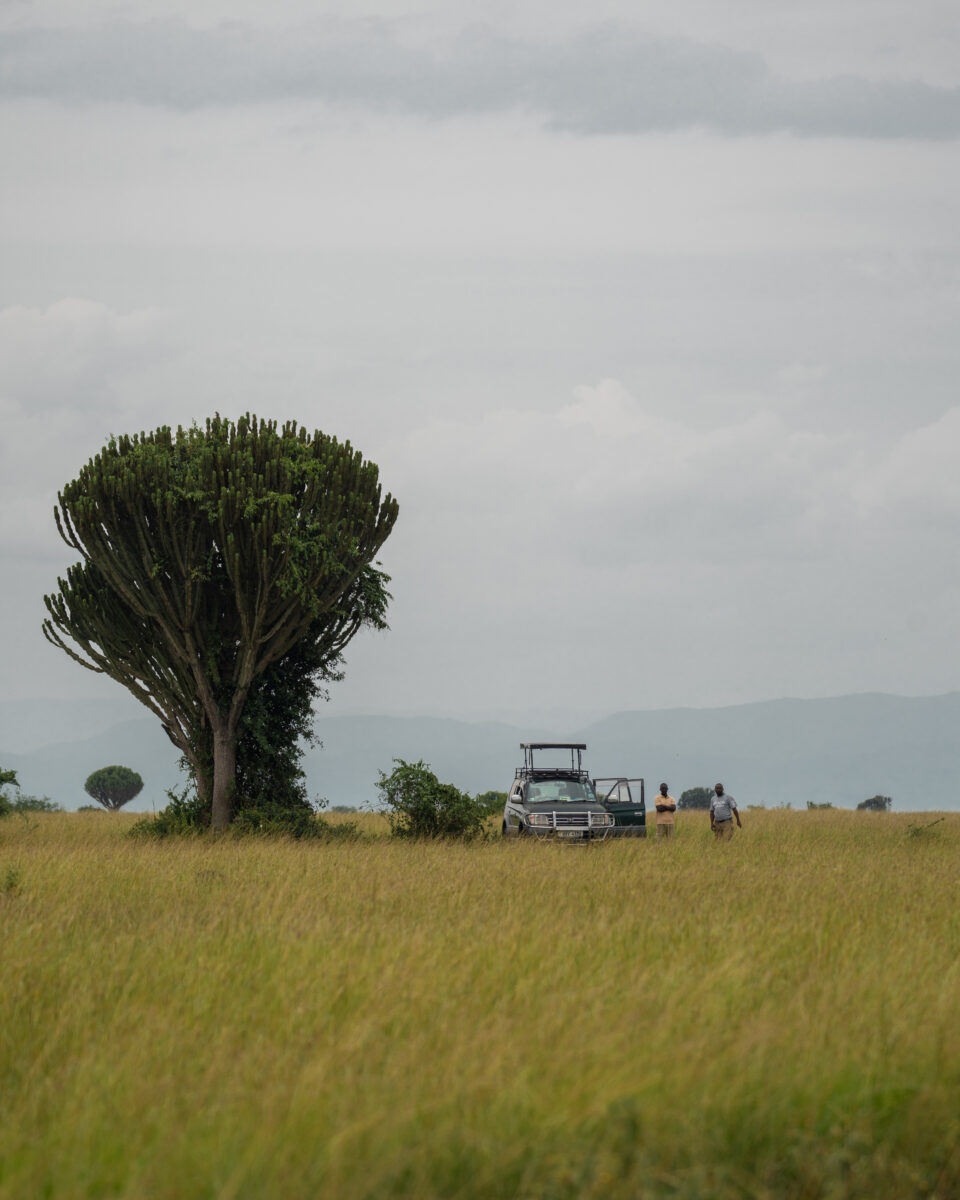
Another BBC camera crew running around through the grass. Look closely at the guy on the right’s hand. He made you look.
Self-driving will save you a considerable amount of money!
The price of renting, especially when split with others is reasonable for something so large. My rental cost was $80 per day plus an extra few dollars for the camping equipment. All said, the vehicle came to about $1600.00 for the trip, which may sound like a lot, but when you break it down and consider the cost of camping vs. a hotel, you’re saving quite a bit of money when compared to someone on a tour.
Don’t expect a new vehicle, but labor in Uganda is cheap so rentals are usually well-maintained. It’s like the owner of my initial guest house in Kampala said, if it’s new, they’ll break it, but if it’s worn, they’ll mend it.
Still, beware, Uganda is larger than it may initially appear so you’ll be doing a fair amount of driving. It’s about the size of New England, plus New York State combined.
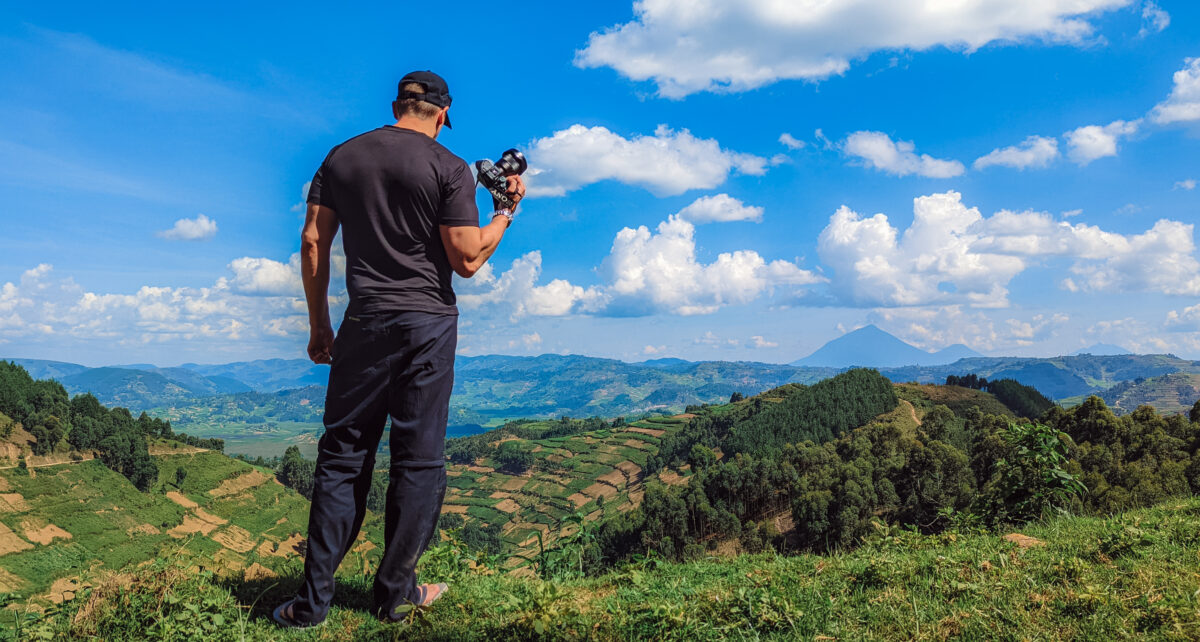
Bribes
I feel like this bears mention, as the police in Uganda can be extremely corrupt, especially in the cities where taking bribes is far more lucrative than their base salary.
If they see you doing something that they can pull you over for, their general script, especially if you’re a foreigner, will be them going on about how expensive tickets can be with court fees and how much time the process will take. It will be soooo inconvenient for you. They make it sound extra dramatic, but it is true. It’s quite a hassle.
I was told by the owners of the guest house I stayed at the first night to ask them if they wanted any water, as a way to show them that I was willing to play ball.
Well, we were pulled over twice, and in both instances, they didn’t have any idea wtf we were talking about. Both situations ended with, how about I just give you $20 USD instead? I wasn’t quite so blunt about it, and this was less than the amount initially asked for, though they did make their request in Ugandan shillings. Regardless, it worked.
Not gonna lie, even though it’s a way of life there, I felt dirty for paying a bribe.

The second equator crossing. This one is in the middle of nowhere so there was far less fanfare. At the very least give us a better sign like at the Tropic of Capricorn in Namibia!
Is Uganda Expensive?
Yes. Uganda is expensive. People I know always tend to assume Africa is a cheap place to visit, and in certain capacities, it is. Food, for example, is very cheap, but being a tourist is what gets you. Once you’re in the country, everyone has their hand out. There are gate fees to enter a park, then park fees to be in the park, car fees to have your car in the park, car fees just for being in someone else’s registered car, safari fees, gorilla or chimpanzee permit fees. Everything.
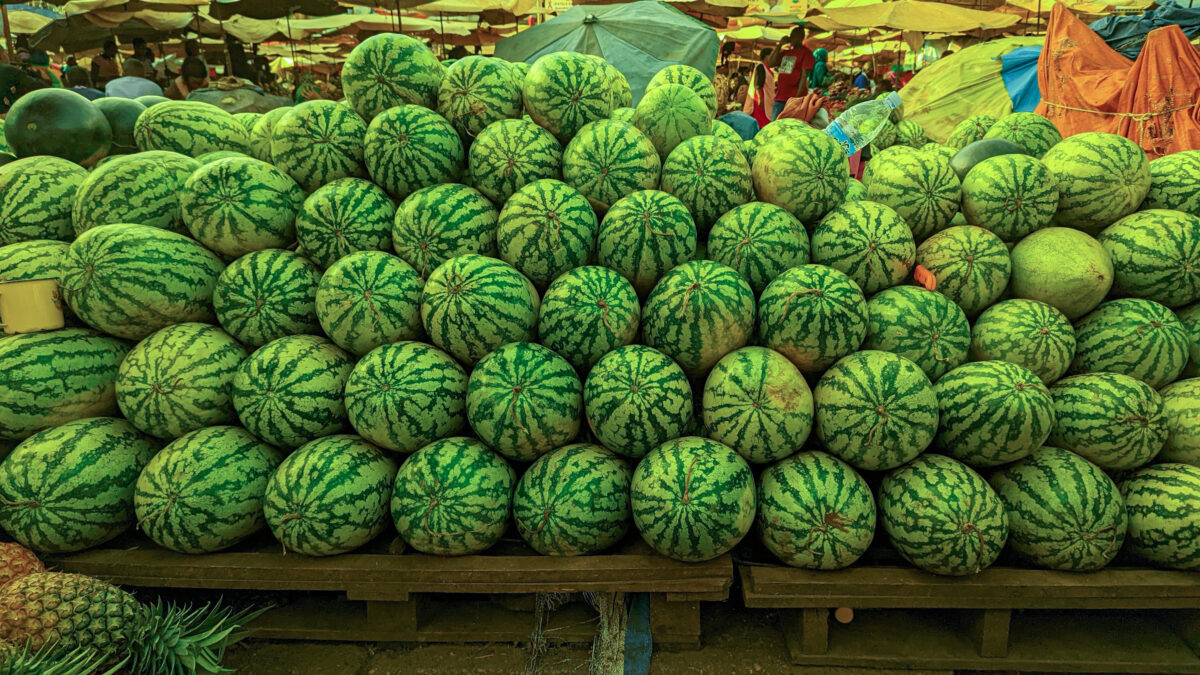
Would you like a watermelon? Cost? Two for $0.25 Yes, you read that right.
While staying in Jinja, we attempted to go to Speke’s Camp & Sporting Bar for lunch. It could be seen from camp on the other side of the river and looked like a fun and lively place.
There was a gate at the top of the road that charged foreigners $20 just to drive down.
I asked why; he said it’s the Source of the Nile. I said you can see the Source of the Nile from everywhere for free and then proceeded to point at the spring. “It’s literally right there.” He wasn’t budging though. He laughed and walked off. Whatever. The much fancier place I ended up eating at had its own dinosaur, so take that.
Anyway, if you ask why everything is so expensive, it’s all in the name of conservation. I may be a bit suspicious of how much is actually for conservation at places like Speke’s Camp & Sporting Bar, but other places like Ziwa are worth the cost.
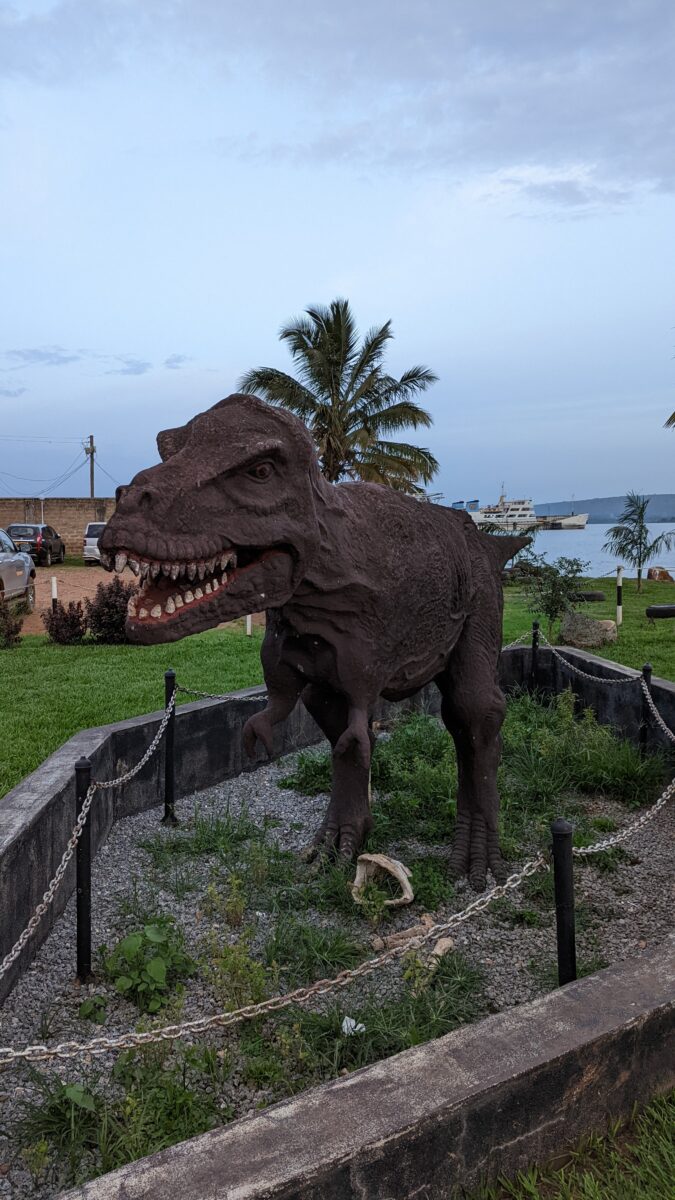
The dinosaur at the Jinja Sailing Club. I feel obligated to show this, given how nice the restaurant really was.
Cash
One final thing to note is the use of cash in Uganda.
Ugandan Schillings are the main form of currency in Uganda, but US Dollars are accepted in places such as hotels, rental agencies, and national parks. Just don’t try buying a pineapple from a fruit stand with a five-dollar bill.
The most important thing to know about using foreign cash though is the condition of the bills. This is something I wish I had known sooner because it was a massive headache to the point where I got in an argument with the company we rented the vehicle from.
My rental company wanted to be paid in cash for the vehicle, and in small bills. So, first, wrap your head around having to carry around $1600 in twenties. To play it “safe” I brought $2000 cash with me. It looked so ridiculous that my dad thought I was going to get my pocket slashed when he dropped me off in NYC.
Be sure to check in advance, because paying only with $20s didn’t seem to be standard practice.
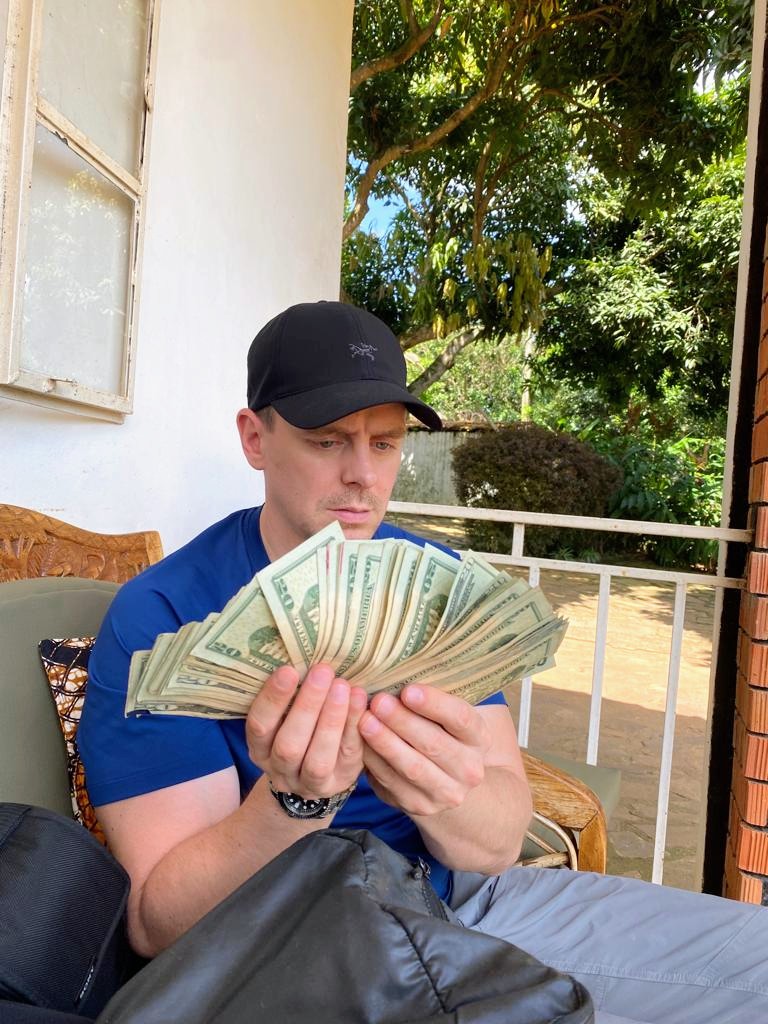
About to count out $1600 in twenties. I can’t even express how badly I wanted to throw this up in the air with one hand. See the red ink in the middle? Those were unacceptable!
Clean Bills Only!
The problem here was that most places in Uganda won’t accept a foreign currency that has any type of damage, no matter how slight. This means no nicks or tears, or markings of any kind. Even a little line of ink from a pen is unacceptable.
The company failed to communicate this with me so I was forced to go through all $2000 looking for the pristine bills. In the end, I had less than $1600 worth that was unmarked. This then turned into a huge hassle (and the argument) because they didn’t want to take the others.
They claimed that the banks wouldn’t accept bills with marks and they’d be stuck with them. In the end, they begrudgingly settled and took a few with some slight pen marks when I not so delicately drove home the point that they should have told me this way back when they said I had to pay in US Dollars.
And wouldn’t you know… Over the course of the trip, I walked into more than one bank and currency changer to get schillings without them even looking at the marked bills. Oh well.
So! Bribes and marked bills aside, how does Uganda sound to you?
Please be sure to share and comment below! I’d love to hear what your favorite part of Uganda is! And as always, thanks for reading!
DID YOU ENJOY THIS ARTICLE? PIN IT!

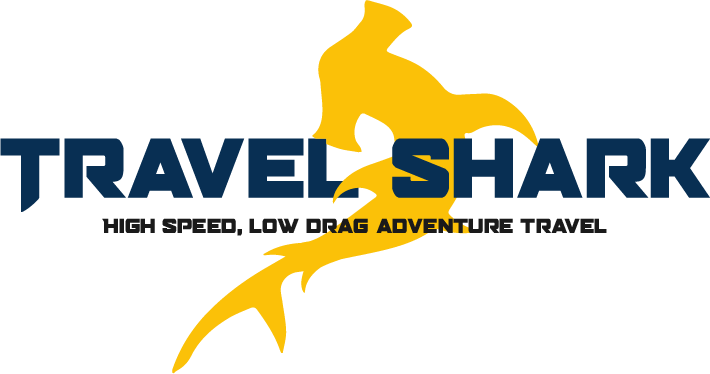
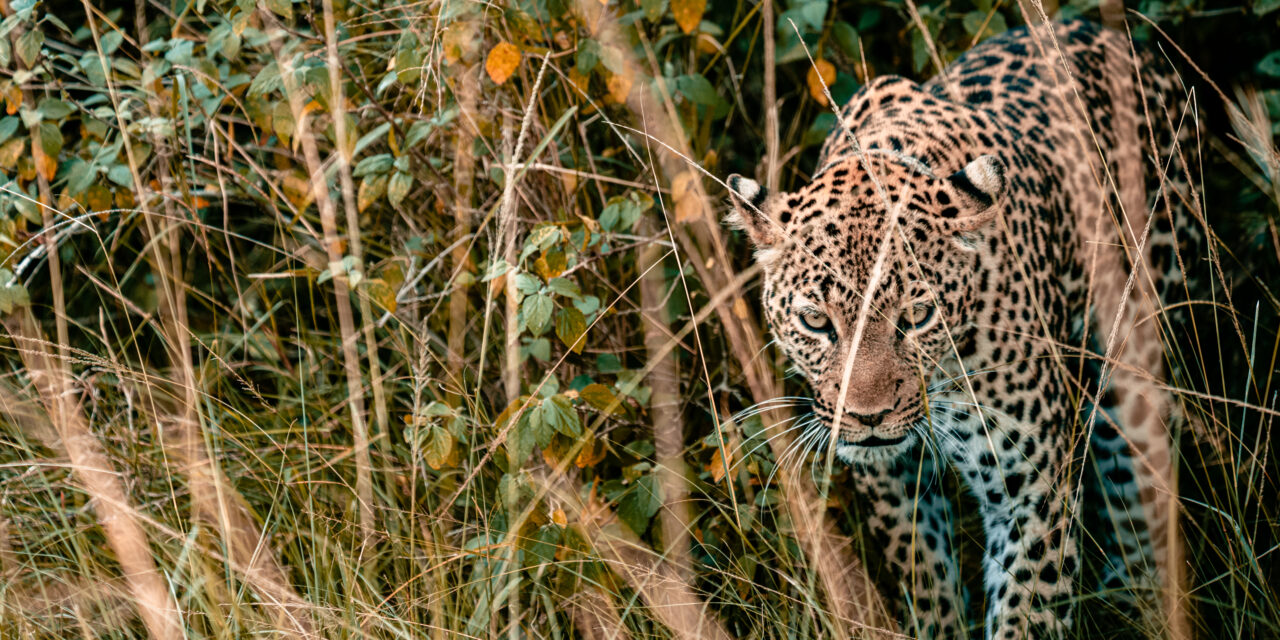
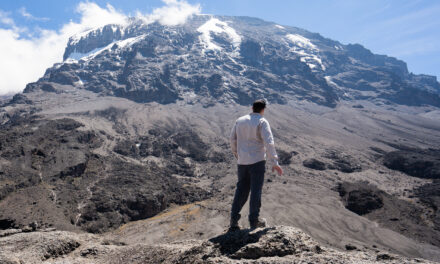
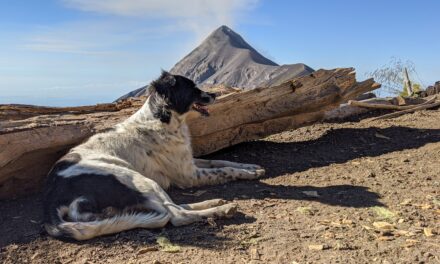
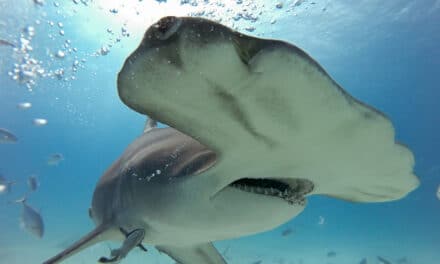
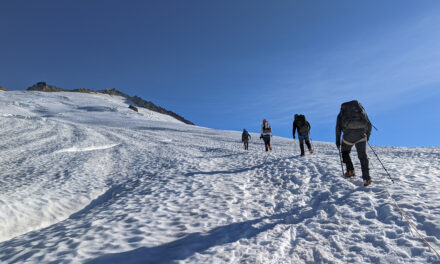
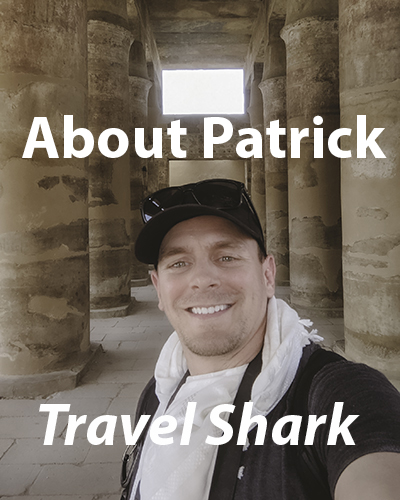
Bunyoni, a Crater lake? No chance. No mention of a hundred more interesting visits. Basic info without any depth on the usual sites that everyone goes to. Didn’t even describe how to visit gorillas on a low budget.
Hi buddy. Google “Is Lake Bunyonyi a crater lake?” Most of the results say it is, including the people from the resort who I asked about it. If it isn’t, it’s not the end of the world, but I’m sorry if that ruins your day 🙂
Yes, it’s the basic info on everything as it’s an itinerary blog post and not a book or an activity-specific post where I’d go into more detail. People don’t want to read three pages on why to visit Fort Portal. These are for those who want to know where to go next. Also, you can’t visit the gorillas on a lower budget than I did. (But maybe check out my more detailed/in depth gorilla-specific post anyway… or does that make too much sense?) Anyway… the price of the gorilla permit is the price of the permit, plus a potential service fee (if you book through an operator). There’s no negotiating it. I self-drove there and camped at the cheapest campsite I could find. I suppose you might be able to save some money if you walk the entire way from Kampala.
Also, I refuse to ever look at or own a Lonely Planet book, a fact that I have, for numerous reasons, made well-known in my IG stories. I’d love to hear what else you think is incorrect though, aside from our differing opinions on the type of lake it is. One thing you’re wrong on though, is if you think it’s cheaper to hire an operator than it was for me to self-drive. As I mention, we did the math more than once and saved a lot of money given the amount of stuff we saw. Also, personal opinion, but tours suck.
By the way, congratulations. In over a year of blogging and 5 years of being an Instagrammer, you are officially my first-ever troll. Not gonna lie, I smiled 🙂
[…] hottest place in recent memory is Uganda. I was right on the equator and the temperature hit a very humid 104 degrees Fahrenheit a couple of […]